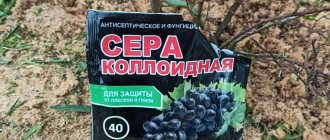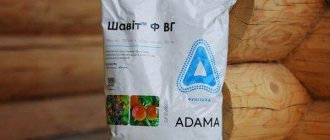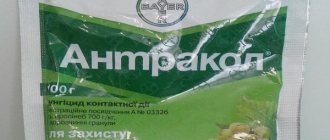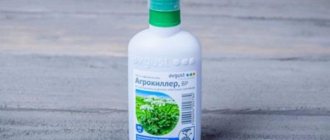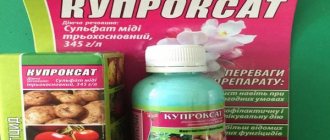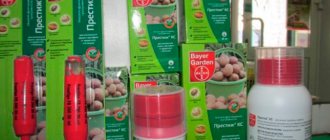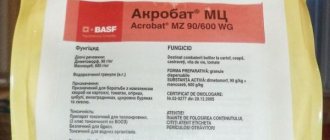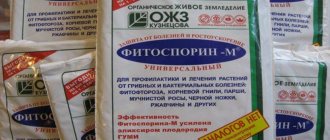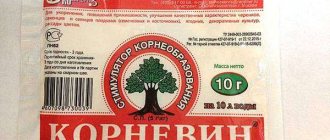Due to regularly deteriorating environmental conditions, it is becoming increasingly difficult for gardeners to grow crops on their plots. Very often, plants become ill with various viral and fungal infections. Chemicals that are actively used to combat such lesions continue to persist in the soil and can accumulate large amounts of nitrates in vegetables. Fortunately, there is a safe remedy - Glyocladin.
Description of the product
Glyocladin is a microbiological agent that was created to actively combat bacterial and fungal diseases on crops. The product belongs to the group of biological pesticides and bacterial fungicides. It is allowed to be used to improve the condition of fruit trees, vegetables, berry bushes, as well as for caring for home crops.
The main active ingredient in the product is the mushroom substance Trichoderma harzianum VIZR-18 . Depending on the air humidity and surrounding temperature, the component continues to act on the crop for 4-7 days. After this, the protective effect of the drug continues to persist for the next 1.5 months if the culture was treated once.
Glyokladin is produced by the Moscow JSC Agrobiotekhnologiya. Most often, the drug goes on sale in tablet form . They can be placed in special blisters or packed several pieces in a plastic box. This product can also be purchased in a separate jar in quantities of 100 pieces. There is a form in the form of a powder, from which, according to the instructions, a special suspension is created for watering the affected plant.
The name of the product comes from the fungus gliocladin, which is very similar to trichoderma. Even with scientific definitions, their names are very often used as synonyms.
Effect of the drug
According to the instructions for use of Glyokladin, the method of action of the drug is that its active components begin to penetrate the sclerotia of the pathogenic fungus, and then over time dissolve them inside the cell itself.
In other situations, the active substance of the drug takes the pathogenic fungus into the colony through its hyphae and does not allow it to continue to form normally , eventually completely suppressing the effect. In this case, Trichoderma does not enter into a symbiotic relationship with the rhizomes of the culture. It continues to persist in the soil as long as carbohydrates are present in it.
Glyocladin can be used for a variety of purposes. In addition to treating crops, it is also used to treat the soil mixture when planting new crops in a permanent place of growth or when picking a plant. The effective component in the composition helps :
- improve the condition of soil microflora;
- helps to suppress the development of pathogenic fungus in a short time;
- economical to use;
- does not remain in the plant for too long, when using it you can get cleaner fruits;
- Absolutely safe for animals, pollinating insects and humans.
The product can be used to prevent fungal infections not only in the garden, but also when growing indoor crops.
The drug copes best with clay-type diseases. These include :
- fusarium;
- pythiosis;
- verticillium;
- Alternaria blight;
- rhizoctoniasis;
- late blight
It is believed that Trichoderma can produce components that help crops actively grow and develop well. It is for this reason that the product can have a positive effect on the yield of the plant.
Greater results from the use of such a product can be achieved when used on moist open soils, as well as when treating indoor crops whose soil is not too dry. Experts recommend using two forms of the drug : a tablet form for caring for indoor crops and seedlings, as well as a suspension for adult plants in a summer cottage. It is with this use that you can minimize the chance of soil acidification and the appearance of an unpleasant odor.
Bottom line
Glyocladin is a highly effective drug for disinfecting soil from pathogenic fungal microflora. The principle of action of the fungus Trichoderma harziannum is to displace pathogenic microflora and replace it with its own fungal colony. This antagonistic mushroom copes well with any type of pest agent, eliminates diseases of all types of garden and ornamental crops. Also well suited as a prophylactic agent for soil disinfection.
Trichoderma harziannum quickly entwines colonies of other microorganisms, suppressing their spread and reproduction. The fungus itself reproduces by spores, especially rapid reproduction occurs on moist and organic-rich soils. To create comfortable conditions, the mycelium needs to mulch the soil well. Trichoderma harziannum will only grow under a thick layer of mulch with sufficient heat and moisture.
The biofungicide does not accumulate in the fruits and leaves of garden crops, therefore it is not toxic to humans and domestic animals. The drug is not dangerous for bees, water inhabitants and the environment. This environmentally friendly and healthy product can be used without restrictions on any garden plots in any area. Before use, read the instructions carefully so as not to ruin the mushrooms.
Instructions for use
When purchasing Glyocladin tablets, it is important to carefully analyze the features of their use. To begin with, it is important to remember that the drug is not used for spraying crops.
It is used only for adding to the soil mixture . At the same time, the drug continues to be active only on the upper layers of the soil, where access to oxygen is provided.
The best conditions for using such a drug will be a soil depth of no more than eight centimeters, a temperature of no higher than 25 degrees Celsius, a humidity level of 65 to 80 percent and an acidity of about 5 pH. Even a slight deviation from the norm results in the growth of the fungal root system stopping, which greatly affects the effect of the product.
Reviews from gardeners
You can only track how effective the product is and how easy it is to grow crops by studying reviews. Recommendations left by users are mostly positive:
Lydia (28 years old). I used Glyokladin for the first time a year ago. Despite the fact that the drug is bacterial, the effect is simply remarkable. I have always been wary of such protection products, but the manufacturers of this product simply delighted me with their product.
Margarita (35 years old). Efficiency, high yield, safety are the three main indicators of the drug. I use Glyokladin tablets for tomatoes and cucumbers. The result exceeds even our wildest expectations.
Victor (41 years old). For greenhouse cultivation, tablets are the best help for obtaining a protective effect. Pleased with the purchase. The recommendations are the best: young plants are not only protected from diseases, but also grow much faster. The results are always impressive. The main condition is compliance with the application rules. Some users recommend diluting and applying liquid to the root, but it is best to follow the manufacturer's directions.
Outdoor crops
For plants planted in open ground, you need to use one tablet per crop or per 300 milliliters of liquid. If the drug is used for a shrub or seedling, depending on the overall size of the plant, it is allowed to place from 3 to 4 capsules under one plant. It is important to remember that Glyocladin capsules do not dissolve in liquid.
Due to its insolubility in water, experts advise using the drug for compact plants in a summer cottage : strawberry bushes, as well as for seedlings. On large crops, its effect is not so effective in the presence of serious diseases. For large plants, the use of such a drug is allowed only for preventive purposes.
To create a solution from the powder, take 50 grams of the drug per 0.5 liter of water, this amount will be quite enough to treat a hectare of land. The suspension is poured into a watering tank and applied for several hours until it loses all its beneficial qualities. After the procedure, the soil in the area with the plant is plowed to a depth of about 25 centimeters.
How to make a working mixture
For small areas, the composition in tablet form is suitable. It must be applied manually or using a dispenser. The tablets do not need to be mixed with water or used to treat above-ground plant fragments. If necessary, the drug can be crushed. However, this is usually not required, since the tablets are quite loose and easily crumble during watering.
To treat large areas, you can use a suspension solution. To do this, the required amount of concentrate must be mixed with a certain amount of water.
Houseplants and Glyocladin
When picking indoor crops, one tablet of the product is placed in a new pot. But if the diameter of the pot exceeds seventeen centimeters, you will have to use three tablets. If the diameter of the container for planting a crop reaches twenty centimeters, then you need to use four tablets.
When using three tablets, they must be placed inside the pot at the same distance from each other. In other cases, capsules are placed at a close distance from the roots of the crop. It is important to remember that the tablets are prohibited from being deepened more than seven centimeters. Also, the drug does not tolerate neutral or alkaline soil mixtures; the room temperature should not be below 20 or above 25 degrees Celsius, as this negatively affects the growth and development of beneficial fungus.
The mycelium of Trichoderma continues to form throughout the week, after which the pathogenic fungi begin to cease their effect, and eventually disappear completely. If the drug Glyokladin does not have a positive effect on the crop, this means that the gardener was simply late in treating the plant.
Media Compatibility
It is forbidden to use such a drug in conjunction with chemical fungicides and pesticides, since in this case the additional agents block the action of Trichoderma, and in some cases even destroy the beneficial fungus.
After deepening the capsules with active substances in the composition, the use of fungicides should be abandoned for at least several weeks. also prohibited to use the drug in combination with other products that contain strains of this fungus. It is allowed to start taking them only after five days from the date of use.
Together with this remedy, the drug Planzir is approved, which has a bactericidal effect, inhibiting the effect of bacterial rot.
Action
Preventive effect of phytolavine on plants
The active principle of phytolavin is the so-called. FTM (phytobacteriomycin) is a complex of streptothricin antibiotics. FTM is a product of the struggle for survival of soil mold fungi; in this it is similar to penicillin and other antibiotics. The chemical basis of FTM is somewhat similar to that of biomycin and streptomycin, but is “targeted” at plant pathogenic microorganisms. Disputes between “our own” people, i.e. the presence of F is other fungi, and FTM simply kills harmful bacteria. Its effect on beneficial soil bacteria is weaker, but FTM still inhibits them, so after adding phytolavine, the soil needs to be replenished with living biological products. In a small private farm or greenhouse, it is often enough to add more affordable purchased or homemade EO preparations, see below.
Rules for working with the tool
For humans, such a drug is not dangerous, since it belongs to the fourth group and is almost non-toxic. The product has low toxicity for bees and is completely non-toxic for plants. This product is also allowed to be used on crops growing near reservoirs in which fish are bred.
Features of using the drug:
- It is prohibited to store such a product together with feed, food products, and medicines. It is also prohibited to transport the biological product Glyokladin on an airplane. Before working with the drug, it is important to wear special gloves. During this time, smoking, eating or drinking is prohibited. Glyokladin should be stored in a place inaccessible to children and animals.
- If a capsule of the drug was accidentally swallowed, depending on the total amount, various reactions of the body can be detected: nausea and vomiting, diarrhea, anaphylactic shock. In this case, it is very important to lavage the patient’s stomach, give him an activated carbon tablet to drink, based on a special proportion, and call a specialist.
- If part of the product enters the body through the respiratory tract, then you just need to go out into the fresh air and get rid of the symptoms that appear. If the medicine gets on the mucous membranes, you just need to rinse them well with water.
- If the product has spilled, it must be collected with a broom and thrown away or applied to the soil with the planted plant, first diluted with water. After using gliocladin, it is recommended to treat pots with plants with a 2% solution of caustic soda or milk of lime.
To store the drug, it is important to choose a dry place with a general temperature of no less than -30 and no more than +30 degrees Celsius. The best temperature for storing the product will be from +5 to +15 degrees Celsius. Without opening the packaging, the product can be stored for several years.
Glyocladin is an effective antifungal agent of biological origin. It helps to overcome a large number of fungal infections on the plant, and is also characterized by minimal toxicity.
Precautionary measures
Phytolavin is a substance of the 3rd hazard class. It has a weak effect on bees: they can be released 12 hours after treatment with phytolavine, so this product is applicable during flowering of plants. In humans, phytolavine can cause irritation of the skin and mucous membranes, and if ingested, antibiotic poisoning. In general, phytolavin is low-toxic for warm-blooded animals, so it is not necessary to wear a full set of PPE to work with it: clothing that covers the body, latex gloves for hands, glasses and a hat are sufficient, see Fig..
Minimum set of personal protective equipment for working with phytolavine
However, in the aquatic environment, in the presence of organic compounds, PTM forms persistent and much more harmful complexes, therefore, the entry of phytolavine into water supplies and open reservoirs is unacceptable. In a humid and warm greenhouse atmosphere, the effect of PTM on a person increases, and to work with phytoavalanche in a greenhouse, it is advisable to wear a plastic raincoat with a hood with an elastic band and protective goggles over work clothes. In this case, a regular petal respirator can serve as a means of respiratory protection. First aid measures if phytolavine gets on the body and into the body are as follows:
- If it gets on the skin, rinse with water, wash the affected area with water and 60% or 72% laundry soap (not with synthetic detergents or white laundry soap!) and rinse again with water.
- In case of contact with eyes, rinse them open under running clean water.
- If it gets on your lips or in your mouth, rinse 3-4 times and spit. Rinse the mouth, not the throat, i.e. keep your head tilted down.
- If ingested, drink 3-4 glasses of water, stirring one pharmacy activated carbon powder in each and induce vomiting.
Elimination of fusarium
Fusarium is a disease that occurs after the active life of the parasite. And although the infection is described as the spread of individual foci, in most cases it leads to mass death of cucumber crops. Visible signs of the disease include the following manifestations: sporulation of a parasitic fungus on the leaves of the crop, deterioration in the strength of the stem, especially at the base, rot on the roots of the plant, pink or white coating. The leaves begin to actively wither, and over time the crop dies completely.
The same phenomenon can occur on tomato bushes. Wilting of leaves begins with signs of chlorosis. They turn greenish-yellow, curl and completely fall off over time. There is a brown coating on the root collar of the crop.
Treatment of lesions in cucumbers begins with pre-treatment of planting material. Disinfection is carried out by steaming the seeds . Three days before sowing the crop, capsules of the drug are added to the soil. They help improve the soil microflora and increase the plant’s resistance to infections and various damages.
It is important to eliminate diseased tomato bushes, take them out into the garden and burn them. It makes no sense to treat an already affected crop, and it is also quite dangerous for the reason that there is a high chance of the disease spreading to other healthy shrubs.
The best way to protect against fungus is to disinfect the soil. To do this, use potassium permanganate, boric acid or dolomite flour. Glyocladin is allowed to be used only in the early stages of plant infection , as well as for the prevention of possible diseases. It is recommended to process tomatoes after every rain.
